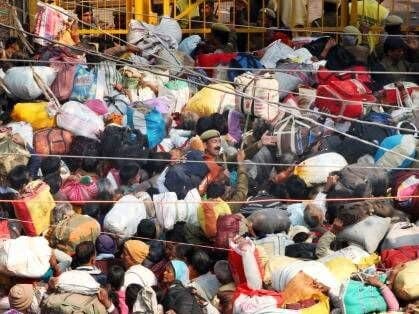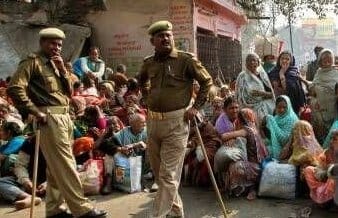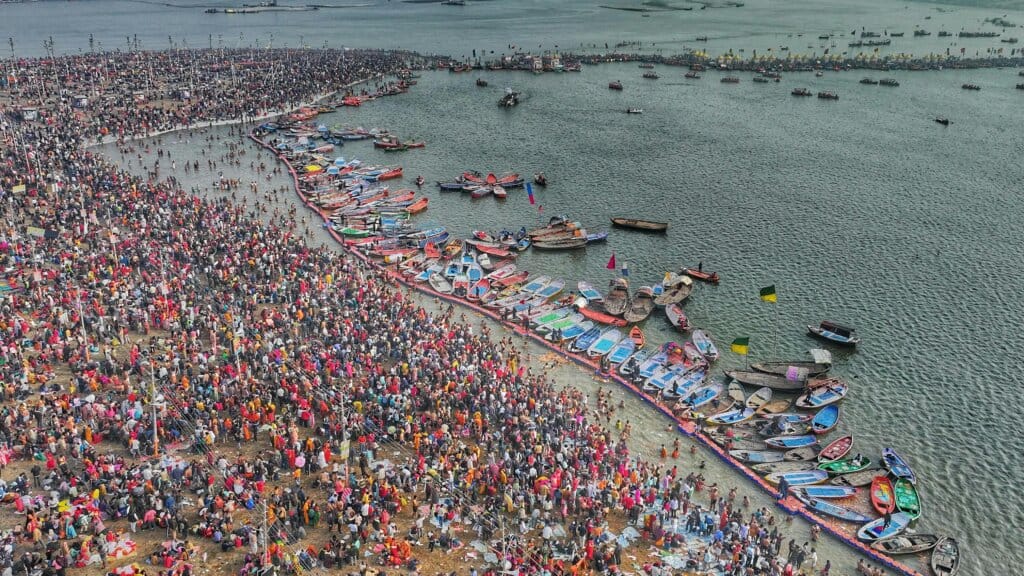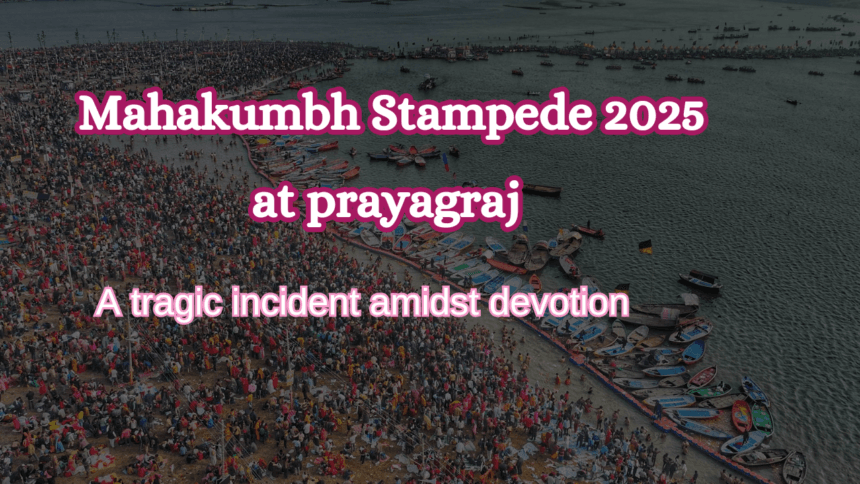The Maha Kumbh Mela, one of the world’s greatest religious gatherings, descended into chaos and sadness on January 29, 2025, when mahakumbh stampede erupted in Prayagraj, Uttar Pradesh.
The sad catastrophe killed at least 30 individuals and wounded more than 60 more.
The rush occurred in the early hours of the morning, when millions of devotees congregated at the Triveni Sangam—the confluence of the Ganges, Yamuna, and the legendary Saraswati—for a sacred plunge.
The tragedy has prompted concerns about the safety protocols in place for such a large festival, which attracts millions of pilgrims from throughout India and beyond.
As officials examine the reasons of the accident, bereaved families grieve their loved ones, and the country considers the need for better crowd control during huge religious events.

What led to the Mahakumbh Stampede?
The rush happened on Mauni Amavasya, one of the most auspicious bathing days during the Kumbh Mela.
This day is regarded to be spiritually strong, bringing a large number of pilgrims.
Authorities had already anticipated a larger-than-usual throng, but the situation swiftly spun out of control owing to a variety of factors:
Overcrowding and breach of Barricades
According to sources, the commotion started when a group of devotees attempted to burst through the barricades to join a procession of saints and holy men (Naga Sadhus).
These processions, known as Shahi Snan (royal baths), are a main attraction of the Kumbh Mela, bringing large crowds to seek blessings from the famed ascetics.
Witnesses reported that as security forces attempted to manage the situation, the throng pushed forward, resulting in a stampede.
With limited space and many crowding from behind, individuals began to fall and be crushed.
Poor crowd management and route confusion
Survivors of the tragedy reported that several paths leading to the bathing ghats had been blocked or diverted, adding to the confusion.
Many pilgrims, ignorant of other ways, became stranded in tight lanes with no visible exit.
An older devotee recalled the terrifying scene: “We were heading towards the ghat when suddenly people began rushing. Some fell, while others pressed onward. There was no room to move. I was fortunate to escape, but I witnessed victims crushed under the boots of others.”

Panic and lack of emergency response at stampede
When the rush erupted, fear quickly spread, exacerbating the situation.
The large number of individuals and the absence of timely medical attention aggravated the problem.
By the time officials arrived, several people had died from their injuries.
The Immediate Aftermath at stampede
The sight following the rush was one of desolation. Bodies lay spread on the ground, while personal possessions such as bags, shoes, and clothing were left behind in the commotion.
Several injured people were spotted pleading for aid as emergency crews rushed to evacuate the scene.
Death toll and injuries
According to official sources, at least 30 individuals died, and around 60 were critically injured.
The majority of victims were old people or ladies who couldn’t get away from the mob.
Several youngsters were also reported missing during the stampede.
Rescue for Medical aid
Authorities promptly deployed rescue teams, and the injured were sent to local hospitals.
However, witnesses stated that it took hours for adequate medical assistance to arrive.
Several injured pilgrims had to be carried by other devotees owing to a paucity of stretchers and ambulances in the aftermath.
Political reaction and official responses on stampede
Prime Minister Narendra Modi’s statement
Prime Minister Narendra Modi extended his sympathies on social media, saying he was deeply grieved by the loss of lives during the Kumbh Mela.
My heartfelt thoughts and prayers are with the victims and their families.
“The government will provide all possible assistance.”
The Uttar Pradesh Government’s Actions
Uttar Pradesh Chief Minister Yogi Adityanath has demanded a judicial probe into the event and offered compensation.
₹25 lakh to relatives of the dead. ₹10 lakh for major injuries.
In addition, a three-member team was created to analyze the actual reasons of the stampede and provide solutions to prevent similar disasters in future.
Opposition criticism on stampede
Opposition politicians, including Rahul Gandhi, attacked the government’s handling of the tragedy and accused it of incompetence.
Gandhi stated that the tragedy may have been averted with greater preparation.
The emphasis was on VIP protection rather than the safety of regular believers.
“His comments prompted a political discussion over the administration’s role in safeguarding the safety of millions who attend such gatherings.
Eyewitness accounts: voices from the ground
Several eyewitnesses described their horrific experiences:
An 80-year-old devotee from Madhya Pradesh said, “I’ve been going to the Kumbh for decades, but I’ve never witnessed such mayhem.
There were no clear directions, so as the throng surged, people raced in all directions. I noticed corpses laying on the ground, helpless.”
A local seller near the ghats said, “I was selling food when there was a commotion.”
Within minutes, people were tumbling over one other.
Women cried, and children were lost. “It was terrifying”.
These personal stories underscore the terror and chaos that erupted in minutes, leaving many people unable to leave.
Historical Context: Stampede at kumbh mela
Unfortunately, stampedes are a repeating tragedy in the history of the Kumbh Mela.
1954 One of the bloodiest stampedes ever recorded occurred at the Allahabad Kumbh Mela, killing almost 500 people.
2013 Allahabad Kumbh Mela, A railway station stampede killed 42 people owing of overpopulation.
Despite the lessons garnered from previous accidents, the 2025 tragedy demonstrates that crowd management remains difficult.

The way forward: Ensuring safety at large gatherings
With the Maha Kumbh Mela still continuing and several important bathing dates ahead, officials must act quickly to avert future catastrophes.
Experts and officials have proposed many measures:
Improved crowd control measures
Additional guards will be deployed at entrance and departure points.
Real-time monitoring with drones and CCTV cameras.
Improved collaboration between the police and volunteers.
Increased public awareness
Signboards and digital displays to direct enthusiasts.
Clear announcements about movement limits.
Use of Technology
Mobile applications for route planning and crowd tracking.
AI-powered crowd density monitoring provides early warnings.
With effective execution, such steps can assist to prevent such calamities in the future.
Conclusion
The Maha Kumbh Mela is a symbol of faith and devotion, attracting millions of visitors seeking spiritual awakening.
However, the 2025 stampede has once again highlighted the perils of poor crowd control at such large events.
As investigations continue, the focus must be to improve safety measures, offer better emergency response systems, and guarantee that such a catastrophe never occurs again.
For the victims’ relatives, this Kumbh Mela will be remembered not as a supernatural blessing, but as a day of great grief.
The issue remains: Will authorities learn from their mistakes, or will history repeat itself?
Also learn about mahakumb 2025 arrangements and why is it so special









